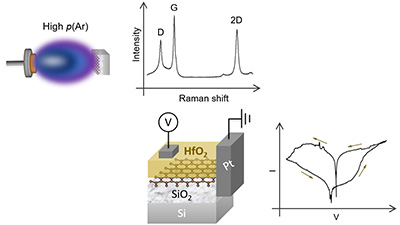Dr. Urška Trstenjak from Department for Advanced Materials Department at Jožef Stefan Institute, together with the Electronic Materials research group (PGI-7) from, has published a paper entitled Heterogeneous Integration of Graphene and HfO₂ Memristors in Advanced Functional Materials. Using pulsed-laser deposition (PLD) the team successfully syntheiszed HfO₂ thin films on graphene/SiO₂/Si templates via quasi van der Waals growth. By analyzing the data obtained from Raman spectroscopy in detail, they found that the defects induced in the graphene by the HfO₂ deposition are predominantly sp²-type, and are formed due to the high kinetic energy of the plasma-plume particles. They showed that by replacing oxygen with argon during PLD growth of hafnia, the hafnia layer remains sufficiently oxidized, while the underlying graphene is well preserved and can be used as a bottom electrode for memristive devices. The findings of the study, that graphene can be used for the heterogeneous integration of crystalline HfO₂ thin films, can be ulitized for the design of other graphene-containing electronic devices.

